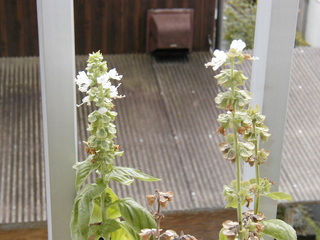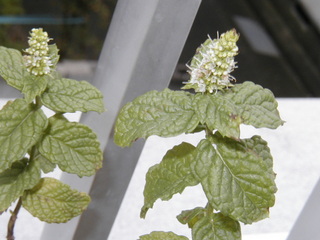Look! They started blooming!

basil

mint
Actually, the basil was already blooming at the end of August, so now you can see some brown parts with seeds inside.
I’m surprised to see the mint flowers. The mint leaves were turning brown in mid August, so I didn’t think they’d survive. But they did and now they’re blooming. Wonderful!
Now I’m especially happy with this green perilla. If you look close, you can see that this one has some kind of disease. Any idea what it is?

Green perilla
To be honest, this was another blooper of mine. In mid July 2004, I found some bugs eating my young green perilla plants. I wanted to avoid insecticide as much as possible, and also I was too lazy to go to the store to buy one. So I searched on the internet to find a “home-remedy” kind of solution. In some Japanese homepages, I read that you could spray milk on plant louses to kill them. I liked the idea and I sprayed A LOT of milk, even though I was sure that the insects eating my green perillas weren’t plant louses. What could kill the plant louses could kill whatever the insects as well, I thought.
Under the hot summer sun, the milk dried fast and completely coated the leaves. Maybe the coating made the effect of the heat and humidity even worse. Their leaves started looking like this in the photo, and I saw some brown stripes in the stem. Then the leaves turned brown, and eventually all my green perillas died.
Some days later, I bought a cheap nursery plant of green perilla and planted it in the same soil as an experiment. If the new one had the same disease, I would have to throw away the soil, too, I thought. The plant grew perfectly OK up to some point, then again the symptom came, as you see in the photo, but this time without the brown stripes in the stem. They survived somehow, and finally they started blooming!!
I heard that you can make tasty tempura* with the flower buds of green perilla. They say it’s a delicacy and privilege of those who grow the plant at home, because the flower buds of green perilla are not available in stores. I might give it a try soon, since I don’t think I want to eat the leaves of my green perilla.
*Tempura: Japanese-style batter-fried food (fish, meat, vegetables ... or even ice cream!). The batter for tempura shouldn't be too thick. |
![]()


![]()
2 comments:
Hi Obachan
When I first read this article,I thought that your shiso's pores might have been blocked by the milk then the plant was baked in the hot sun which weakened it...but if the second plant had the similar problem,could it be something soil-borne?!Ummm,haven't got a clue.
Never tried this milk method myself but apparently you've got to dilute milk with some water and after spraying,watch out for any sign of mould forming or better still,wash off the milk afterwards.
I think I read somewhere that if the disease was caused by some kind of virus, the soil has to be replaced because the virus stays in it to cause the same problem over and over. But I’m not really sure… I’m sure that I’m not going to use the milk method any more ;)
Post a Comment